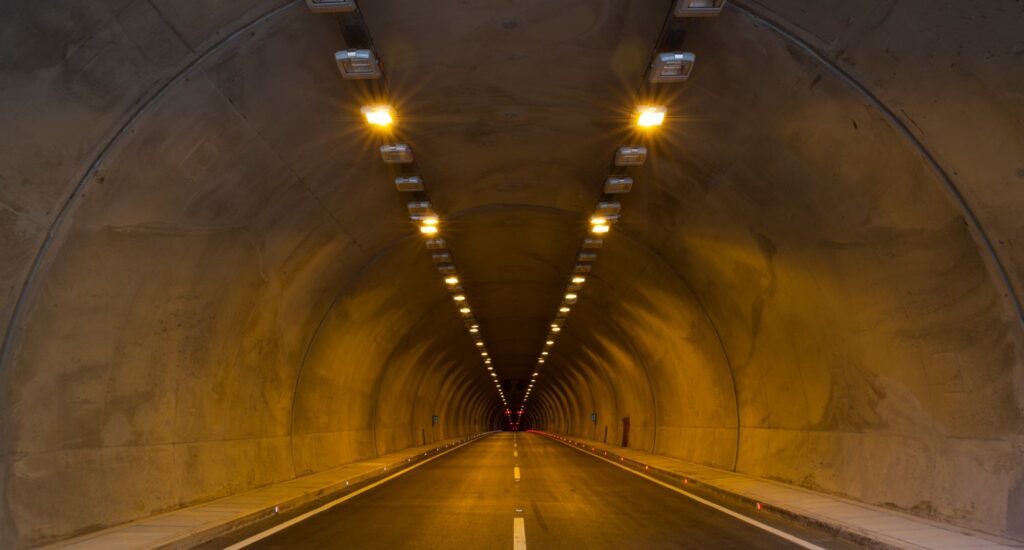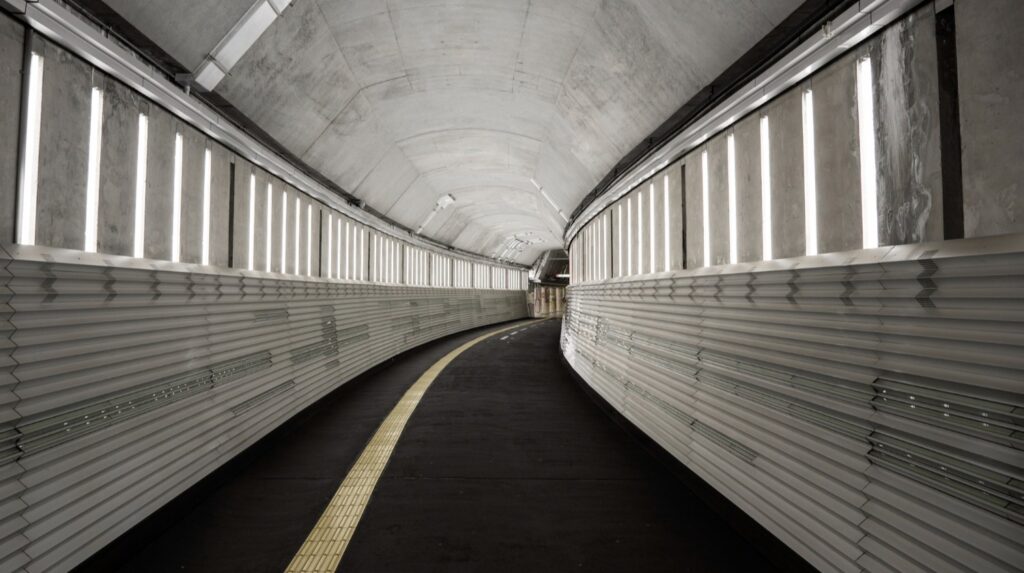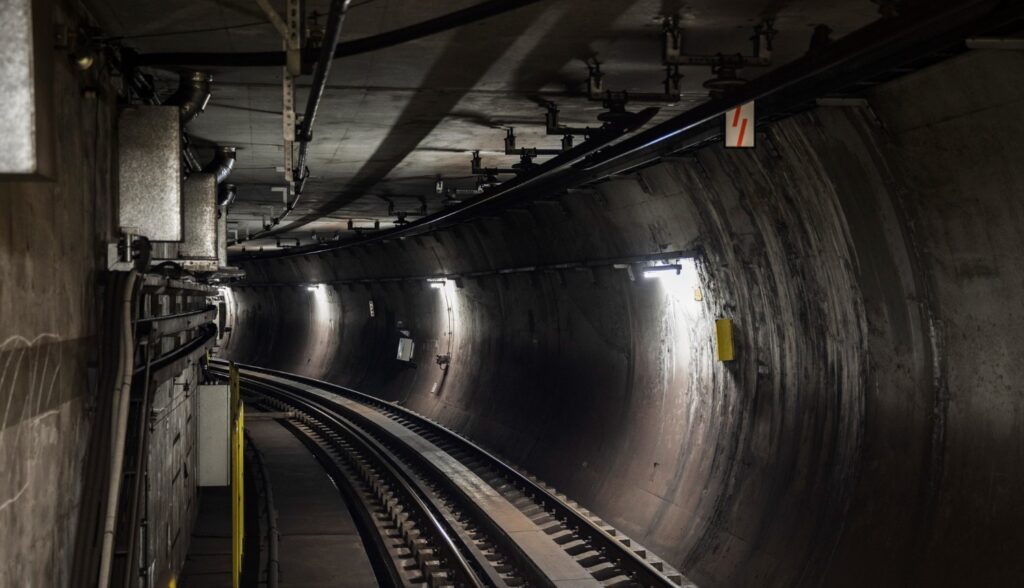History of Severn Tunnel

In British engineering, the Severn Tunnel is a historic monument. Built between 1873 and 1874 by the Great Western Railway (GWR), it Under the River Severn, Sir John Hawkshaw’s tunnel links South Gloucestershire and Monmouthshire. It cut the journey from South Wales to western England.
The Requirement of the Tunnel
Travel before the tunnel consisted on either a lengthy detour via Gloucester or ferry crossings. Neither of the choices was effective. GWR sensed the promise in a tunnel. It would help products as well as passenger transportation. In 1872, parliament approved a legislation allowing its building.
Early Construction
March 1873 saw start of work. At first, there was consistent improvement; but, delays soon ensued. October 1879 saw water from the Great Spring stop work. Pumps were fitted by engineers to control water levels. The team started working once months of preparation were over. Notwithstanding obstacles, the building of the tunnel proceeded.
Reaching Overcomes
Problems with the Great Spring persisted all through the project. Frequent flooding hampered advancement. Efforts at water management were spearheaded by Thomas A. Walker. Alexander Lambert was a diver that helped to seal the flooded region. This helped the work to advance. Two ends of the tunnel at last crossed in 1881.
Final Stages of Construction
The tunnel building was finished in 1885. Not too long afterward were tracks put in place. Goods trains ran from January 1886 via the tunnel. December that same year brought passenger services starting in Travel times were considerably shortened by the tunnel. It also sparked more trade between western England and South Wales.
Maintaining the Tunnel
Maintaining the Severn Tunnel has always challenged us. Still seeping in is Great Spring water. Every day pumps remove fifty million liters of water. The steel rails of the tunnel rust fast. Add to the wear diesel exhaust and dampness. The tunnel must be kept in running order by constant maintenance.
Modernization and Electrification
The tunnel was upgraded in 2016 during the larger electrification project. Engineers placed electric train overhead equipment. The tunnel’s water within complicated the project. The electricity cables were tightly held in place using a unique solid beam method.
Tunnel Closure for Upgrades
The tunnel was closed six weeks for the electrification project. The rail services were redirected. Electric trains started utilizing the tunnel later, in 2020. The update raised train speeds. It also lowered upkeep expenses. For passenger and cargo trains alike today, the tunnel remains an essential link.
Present-Day Operations
Operating difficulties still abound in the tunnel. Still absolutely vital is water management. Inside, the atmosphere causes rapid wear and tear. The tunnel has, nevertheless, lasted for more than a century. Every day, around two hundred trains pass by it. It is absolutely vital component of the railway system in the United Kingdom.
Legacy of the Severn Tunnel
The Severn Tunnel is evidence of British technical ability. Vision of Sir John Hawkshaw turned into reality. Though several obstacles, the tunnel was finished. Its modernism guarantees that it will always be a key link for next generations. It keeps serving England as well as Wales.
Latest

| Attribute | Details |
|---|---|
| Location | Links South Gloucestershire, England to Monmouthshire, Wales |
| Coordinates | 51.575°N 2.6889°W |
| Construction Period | 1873-1886 |
| Length | 7,008 meters (4.355 miles) |
| Underwater Length | 3,621 meters (2.250 miles under the River Severn) |
| Opening Date | First passenger train on December 1, 1886 |
| Design Engineer | Sir John Hawkshaw |
| Main Contractor | Thomas A. Walker |
| Key Construction Milestone | Meeting of two headings on September 26, 1881 |
| Significant Challenges | Flooding from the Great Spring, heavy groundwater ingress |
| Pumping Volume | Approximately 50 million liters of water per day |
| Railway Traffic | An average of 200 trains per day as of 2012 |
| Notable Engineering Feat | Longest underwater tunnel in the world until 1987 |
| Electrification | Completed in 2016 with overhead line equipment installation |
| Modernization | Part of the Great Western Main Line modernization, involves using solid beam technology for tunnel electrification |
| Structural Features | Horseshoe-shaped cross-section, continuous drainage culvert, enclosed drainage channel |
| Historical Importance | Drastically shortened travel time between South Wales and Western England, replacing ferry crossings |
| Maintenance Challenges | Corrosive atmosphere due to moisture and diesel fumes, steel rails replacement every six years, permanent pumping requirements |
List of Longest Tunnels in the World

Engineering works of wonder are tunnels. They let us go across rivers, mountains, and other challenges. Among the longest tunnels in the world, some are absolutely essential for the systems of water distribution and transportation. Let’s investigate the longest tunnels on Earth, so highlighting human creativity and problem-solving.
1. Delaware Aqueduct – 137 km
Longest tunnel in the world is the Delaware Aqueduct. Situated in New York, it brings Catskill Mountains water straight to New York City. Built in 1945, its distance is 137 kilometers. Millions of people live nearby from this aqueduct.
2. Päijänne Water Tunnel – 120 km
Second-longest water tunnel in Finland is Päijänne Water Tunnel. It traverses solid rock for 120 kilometers. Finished in 1982, it provides Helsinki area with water. The tube guarantees the residents of the city with pure water.
3. Gotthard Base Tunnel – 57 km
One railway tunnel beneath the Swiss Alps is the Gotthard Base Tunnel. Opening in 2016, it is 57 km long. Travel time between northern and southern Europe is substantially shortened by the tunnel. Among European rail routes, this is among the most crucial ones.
4. Seikan Tunnel – 53.8 km
The Seikan Tunnel links Hokkaido and Honshu islands of Japan. With much of it going under the water, it is 53.8 kilometers long. Opening in 1988, it provides a vital train connection between the principal Japanese islands.
5. Channel Tunnel – 50.45 km
Under English Channel, the Channel Tunnel connects the UK and France. Among submarine tunnels, it is among 50.45 km long. First opened in 1994, it links the two nations for goods and passenger traffic.
6. Yulhyeon Tunnel – 50.3 km
In South Korea is the Yulhyeon Tunnel. Part of the high-speed train system, it covers 50.3 kilometers. Trains can go three hundred kilometers an hour. Improving transportation efficiency, the tunnel links Seoul with southeast areas.
7. Neelum–Jhelum Hydropower Tunnel – 68 km
Part of a hydroelectric power facility, Pakistan’s Neelum–Jhelum Hydropower Tunnel Comprising 68 kilometers, the tunnel opened in 2017. It supplies water to create nation-wide power.
8. West Qinling Tunnel – 28.2 km
China’s West Qinling Tunnel stretches 28.2 km. Comprising a dual-bore railway tunnel across the Qinling Mountains, Opening in 2016, it is part of a main rail system linking western China.
9. Laerdal Tunnel – 24.51 km
Longest road tunnel in Norway is the Lærdal Tunnel. It links the cities of Lærdal and Aurland and runs 24.51 km. It commenced in 2000. Rest spots in the tunnel help to ease driver tiredness along the twenty-minute trip.
10. Yamate Tunnel – 18.2 km
Tokyo, Japan houses the Yamate Tunnel. Part of the expressway system of the city, it is 18.2 kilometers long. It offers a subterranean path across the city, therefore lessening traffic congestion. 2015 was the completion year.
11. Zhongnanshan Tunnel – 18.04 km
Comprising two bores, China’s Zhongnanshan Tunnel spans 18.04 kilometers beneath the Zhongnan Mountains. Finished in 2007, it is included into the national highway network.
12. Jinpingshan Tunnel – 17.54 km
At Sichuan, China, the Jinpingshan Tunnel stretches 17.54 kilometers. Lead to the Jinping Dam, it is utilized for hydropower. Finished in 2011, the tunnel is a component of a bigger hydroelectric project.
13. St. Gotthard Road Tunnel – 16.9 km
St. Gotthard Road Tunnel length 16.9 km in Switzerland It links Göschenen and Airolo across the Swiss Alps. Originally opened in 1980, it was then the longest road tunnel in the world.
| Tunnel Name | Location | Length (km) | Type | Opened | Significant Use |
|---|---|---|---|---|---|
| Delaware Aqueduct | New York, USA | 137 | Water Supply | 1945 | Supplies water to New York City |
| Päijänne Water Tunnel | Southern Finland, Finland | 120 | Water Supply | 1982 | Main water source for Helsinki |
| Gotthard Base Tunnel | Swiss Alps, Switzerland | 57 | Railway | 2016 | Key rail link in Europe |
| Seikan Tunnel | Japan | 53.8 | Railway | 1988 | Connects Honshu and Hokkaido |
| Channel Tunnel | UK/France | 50.45 | Railway | 1994 | Links UK and France under the sea |
| Yulhyeon Tunnel | South Korea | 50.3 | Railway | 2016 | Part of South Korea’s high-speed network |
| Neelum–Jhelum Hydropower Tunnel | Pakistan | 68 | Hydroelectric | 2017 | Supports a 969 MW power plant |
| West Qinling Tunnel | Gansu, China | 28.2 | Railway | 2016 | Facilitates rail travel in western China |
| Lærdal Tunnel | Norway | 24.51 | Road | 2000 | Longest road tunnel in the world |
| Yamate Tunnel | Tokyo, Japan | 18.2 | Road | 2015 | Reduces congestion in Tokyo |
| Zhongnanshan Tunnel | Shaanxi, China | 18.04 | Road | 2007 | Forms part of China’s highway system |
| Jinpingshan Tunnel | Sichuan, China | 17.54 | Hydropower | 2011 | Access to Jinping Dam |
| St. Gotthard Road Tunnel | Switzerland | 16.9 | Road | 1980 |
Cross-Alpine traffic route
|
List of Most Expensive Tunnels Around the World

Among the most costly constructions projects are tunnels. They overcome difficult transportation problems. Let’s investigate the most expensive tunnels ever constructed as well as their justifications for their hefty cost.
1. The “Big Dig” – Central Artery/Tunnel Project, Boston, USA
Among the most costly tunneling projects ever, Boston’s “Big Dig” Officially known as the Central Artery/Tunnel Project, it ran $14.6 billion. It sought to move Interstate 93 beneath Boston’s traffic congestion, therefore relieving it. Completing the 16-year project took between 1991 and 2007.
2. Channel Tunnel, England and France
Under the English Channel the Channel Tunnel links England with France. Spansing 50.45 miles, it cost roughly £9 billion. Opening in 1994, it lets fast rail link the two nations. Among the longest tunnels in the world, this one runs underwater.
3. Gotthard Base Tunnel, Switzerland
Deeper and longest railway tunnel in Switzerland is the Gotthard Base Tunnel. It passes 57 kilometers beneath the Swiss Alps. Finished in 2016, its cost came at $12 billion. Between northern and southern Europe, this tunnel speeds up goods movement and cuts travel times.
4. Brenner Base Tunnel, Austria-Italy
At completion, the Brenner Base Tunnel will be the longest rail tunnel. Run under the Alps, it links Austria and Italy. Anticipated to cost more than €8.5 billion, this 64-kilometer tunnel will relieve road congestion. More goods will be moved on rail, therefore lowering pollution and increasing efficiency.
5. HS2 Rail Project Tunnels, United Kingdom
A huge infrastructure project in the UK is the HS2 Rail Project. The first phase has 103 kilometres of tunnels. The project’s anticipated overall cost comes at £27 billion. These tunnels will change UK transportation by cutting the travel times between London, Birmingham, and Manchester.
6. Fehmarnbelt Tunnel, Denmark-Germany
An ongoing development between Germany and Denmark is the Fehmarnbelt Tunnel. Among immersed tunnels worldwide, it will be the longest. Said to cost €7 billion, it will run eighteen kilometers. Travel and trade between Scandinavia and mainland Europe will benefit from this tunnel.
7. SMART Tunnel, Kuala Lumpur, Malaysia
In Kuala Lumpur, the SMART Tunnel is a stormwater as well as a road tunnel. Spans 9.7 km and cost $515 million. It lessens traffic congestion and helps to minimize city flooding. One can find creative urban design in this dual-use tunnel.
Source: noticiasenespanol – actualidadfamosos – starrelationships
| Tunnel Name | Location | Cost (Billion USD) | Length (km) | Type | Completion Year | Purpose |
|---|---|---|---|---|---|---|
| The “Big Dig” (CA/T Project) | Boston, USA | 14.6 | 5.6 | Road | 2007 | Reduce traffic congestion in downtown Boston |
| Channel Tunnel | England-France | 12.0 | 50.45 | Rail | 1994 | High-speed rail link between the UK and France |
| Gotthard Base Tunnel | Switzerland | 12.0 | 57 | Rail | 2016 | Reduce travel time through the Swiss Alps |
| Brenner Base Tunnel | Austria-Italy | 8.5+ | 64 | Rail | 2030s (est.) | Shift freight from road to rail, environmental impact reduction |
| HS2 Rail Project Tunnels | United Kingdom | 27.0 (entire project) | 103 | Rail | 2035 (est.) | Reduce travel times between UK cities |
| Fehmarnbelt Tunnel | Denmark-Germany | 7.0 | 18 | Immersed | 2029 (est.) | Improve travel and freight transport |
| SMART Tunnel | Kuala Lumpur, Malaysia | 0.515 | 9.7 | Road/Stormwater | 2007 | Reduce flooding and traffic congestion |
Most Tragic Tunnel Accidents in History

Building a tunnel exposes great hazards. Tragic results from accidents are shown in history. These are some of the most sad tunnel mishaps, together including the circumstances and their aftermath.
1. Hawk’s Nest Tunnel Disaster (1930s)
West Virginia’s Hawk’s Nest Tunnel sought to channel water for a hydropower facility. Beginning in 1930, construction hired about 5,000 people—many of them African Americans. High silica dust levels resulting from drilling presented dangerous working conditions.
Absence of safety precautions resulted in major medical problems. Many of them contracted the lethal lung illness silicosis. Project estimates point to 764 silicosis deaths among employees. This tragedy made clear how urgently improved safety rules are needed, which led to major revisions in occupational health requirements.
2. Caldecott Tunnel Fire (1982)
One significant fire started in California’s Caldecott Tunnel in 1982. A gasoline truck ran afoul of a bus, starting a terrible fire. Many drivers became caught inside by the fire. Seven persons in all passed away, and others received major injuries.
The episode begged questions about emergency procedures and tunnel safety. Consequently, changes in fire safety precautions were carried out in order to stop next tragedies.
3. Channel Tunnel Fires (1996 & 2008)
Fires presented major problems for the Channel Tunnel connecting the UK and France. Although there were no deaths, a fire on a goods train in 1996 caused great damage. The episode made clear how urgently strict tunnel fire safety regulations are needed.
Another major fire happened in 2008 when a goods train caught flames. The fire resulted in the hundreds of people fleeing. Luckily no lives were lost, but it spurred research on fire safety precautions.
4. Gotthard Base Tunnel (2016)
Renowned for its technical achievements, the Gotthard Base Tunnel in Switzerland suffered tragedies under building. 2016 saw a fatal tragedy happen during rail track installation. This event led to more examination of safety protocols used in big-scale undertakings.
Now the longest tunnel in the world, its enhanced safety features draw on past mishaps. Safety still comes first in next tunneling projects.
5. Sierra Leone’s Tunnels (2014)
Many tunnels built for military purposes during Sierra Leone’s civil war Tragic events resulted from many of these tunnels collapsing. One notable incidence included a tunnel collapse killing more than fifty individuals.
Many times lacking appropriate engineering control, these tunnels presented dangerous conditions. This sad event reminds us of the need of safety rules in building.
6. Saskatchewan Potash Mine (2009)
A potash mine in Saskatchewan had a terrible disaster with an explosion and tunnel collapse. Two workers perished in 2009 from an explosion. The episode made clear how urgently strict safety precautions must be followed in mining activities.
Investigations on safety procedures and practices following the catastrophe produced improved rules safeguarding workers.
7. St. Gotthard Tunnel Disaster (1915)
1915 saw a sad incident during the St. Gotthard Tunnel’s building in Switzerland. More than thirty buried workers behind debris perished in a blast catastrophe. This event brought attention to the risks connected to tunnel building.
Safety precautions were reinforced following the disaster to guard workers in next projects. The requirement of strict safety criteria became clear.
| Accident Name | Date | Location | Fatalities | Description |
|---|---|---|---|---|
Hawk’s Nest Tunnel Disaster | 1930s | West Virginia, USA | 764+ | High silica dust levels caused silicosis among workers, resulting in numerous deaths. |
| Caldecott Tunnel Fire | 1982 | California, USA | 7 | A gasoline tanker fire trapped motorists in the tunnel. |
| Channel Tunnel Fires | 1996 & 2008 | UK/France | 0 | Fires on freight trains led to evacuations and highlighted safety concerns. |
| Gotthard Base Tunnel Accident | 2016 | Switzerland | 1 | A fatal accident occurred during rail track installation. |
| Sierra Leone Tunnels | 2014 | Sierra Leone | 50+ | Military tunnels collapsed during the civil war, causing numerous fatalities. |
| Saskatchewan Potash Mine | 2009 | Saskatchewan, Canada | 2 | An explosion and collapse in a potash mine led to two deaths. |
| St. Gotthard Tunnel Disaster | 1915 | Switzerland | 30+ | A blast accident during construction resulted in worker deaths. |

